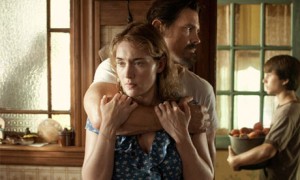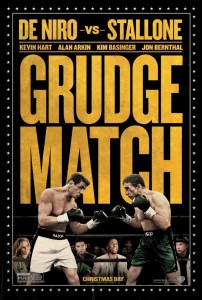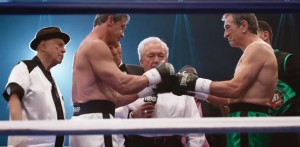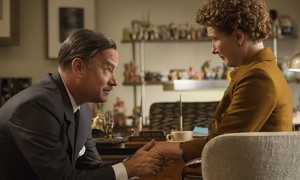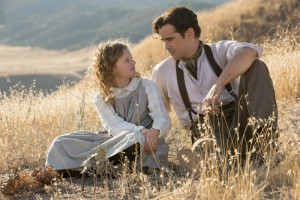The LEGO Movie
Posted on February 6, 2014 at 6:00 pm
A-| Lowest Recommended Age: | Kindergarten - 3rd Grade |
| MPAA Rating: | Rated PG for action and crude humor |
| Profanity: | Some schoolyard language ("butt") |
| Alcohol/ Drugs: | None |
| Violence/ Scariness: | Cartoon-style peril and violence, no one hurt |
| Diversity Issues: | Diverse characters |
| Date Released to Theaters: | February 7, 2014 |
| Date Released to DVD: | June 18, 2014 |
| Amazon.com ASIN: | B00HEQOC2A |
 Everything is awesome in this fast, fresh, funny, and utterly adorable movie set in the vast world of LEGOs.
Everything is awesome in this fast, fresh, funny, and utterly adorable movie set in the vast world of LEGOs.
Last year at Comic-Con the filmmakers said that there are two great things to do with LEGOs — you can follow the instructions and make something awesome. Or, you can ignore the instructions and make something awesome. Here, they pay tribute to both in the storyline and in their own meta-approach to the material, deconstructing classic movie narratives over here, re-constructing them over there, and adding in some delicious humor and sublime guest stars of both the LEGO and human variety. So when a Gandalf-y looking guy with the deep, familiar voice of Morgan Freeman intones a prophecy about a chosen one, we file it away as the underlying frame for the story — for a couple of seconds until he advises the confused crowd that it has to be true because it rhymes. Big-time Lugnuts and Brick-heads will find plenty of in-jokes and wonky charm and those who don’t know their minifigures from their master builders will enjoy the wit, the silliness, and the surprisingly touching conclusion.
The movie winsomely begins with LEGO logos, immediately welcoming us into a playful, tactile world. And then we meet our unassuming hero, the cheerful Emmet (a terrific Chris Pratt), who greets each day with joyful energy and loves everything about his life. At least, that’s what he tells us as he follows the instructions for getting ready for work on a construction site. The song “Everything is Awesome” (from Tegan and Sara) plays brightly everywhere. Instructions are clear and faces are painted in a smile. But Emmett is lonely. Everyone seems to have friends to hang out with but no one invites him to come along. He loves being part of a team but kind of misses having something special and different.
And then, the brave and glamorous Wyldstyle (Elizabeth Banks), with her fetching streaked ponytail, shows up and he follows her down the LEGO equivalent of a rabbit hole to discover that everything he thought he understood about his world of following instructions and being part of a team is at risk. President Business (Will Ferrell) is about to unleash a terrible weapon, and apparently Emmet is the only one who can stop him. There are worlds beside and under worlds and within other worlds here — you could make an “Inception”-style map that takes you from the wild west and Middle Zealand to Cloud Cuckoo-land. The film makes clever use of the properties of LEGOs, their endless variety of characters and projects and their comforting sameness of structure and inflexibility. It avoids becoming an infomercial by keeping the focus on the story and the goal of creativity. Emmet and Wildfire are joined by Batman (Will Arnett’s dry baritone nails it), Vitruvious (Freeman), a pirate cyborg (Charlie Day), and a rainbow unicorn-kitty (Alison Brie). Their foes include President Business’ two-faced henchman whose head swivels to allow him to be both good and bad cop (a very funny Liam Neeson). It would be criminal to give away any of the movie’s many surprises and the mind-bendingly cool guest appearances, but I will mention that a couple of them arrive from a galaxy far, far away.
There are some unexpectedly heartwarming moments about family and the importance of imagination. The bad guy is not called President Business for the usual reasons. And there’s an unusually astute resolution to the final confrontation. I especially enjoyed some very clever satire about the kind of entertainment we too often settle for. If only they had known about Facebook’s 10th anniversary gift to each of its subscribers of “look back” mini-movies of their own lives — but not even “The LEGO Movie” could have come up with anything that solipsistically deranged. But this movie is itself the best possible antidote to the tendency to settle for lowest-common-denominator formula story-telling. It won’t just inspire you to see better movies; it will inspire you to make your own.
Parents should know that this film has cartoon-style peril and violence with many threatened injuries but no one hurt, a parent-child confrontation, some potty humor, and schoolyard language.
Family discussion: How do you decide whether you are special? Is it more fun to follow directions or make something up? What parts of the LEGO world do you recognize?
If you like this, try: the “Toy Story” movies and “Robots” — and build something with LEGOs!

